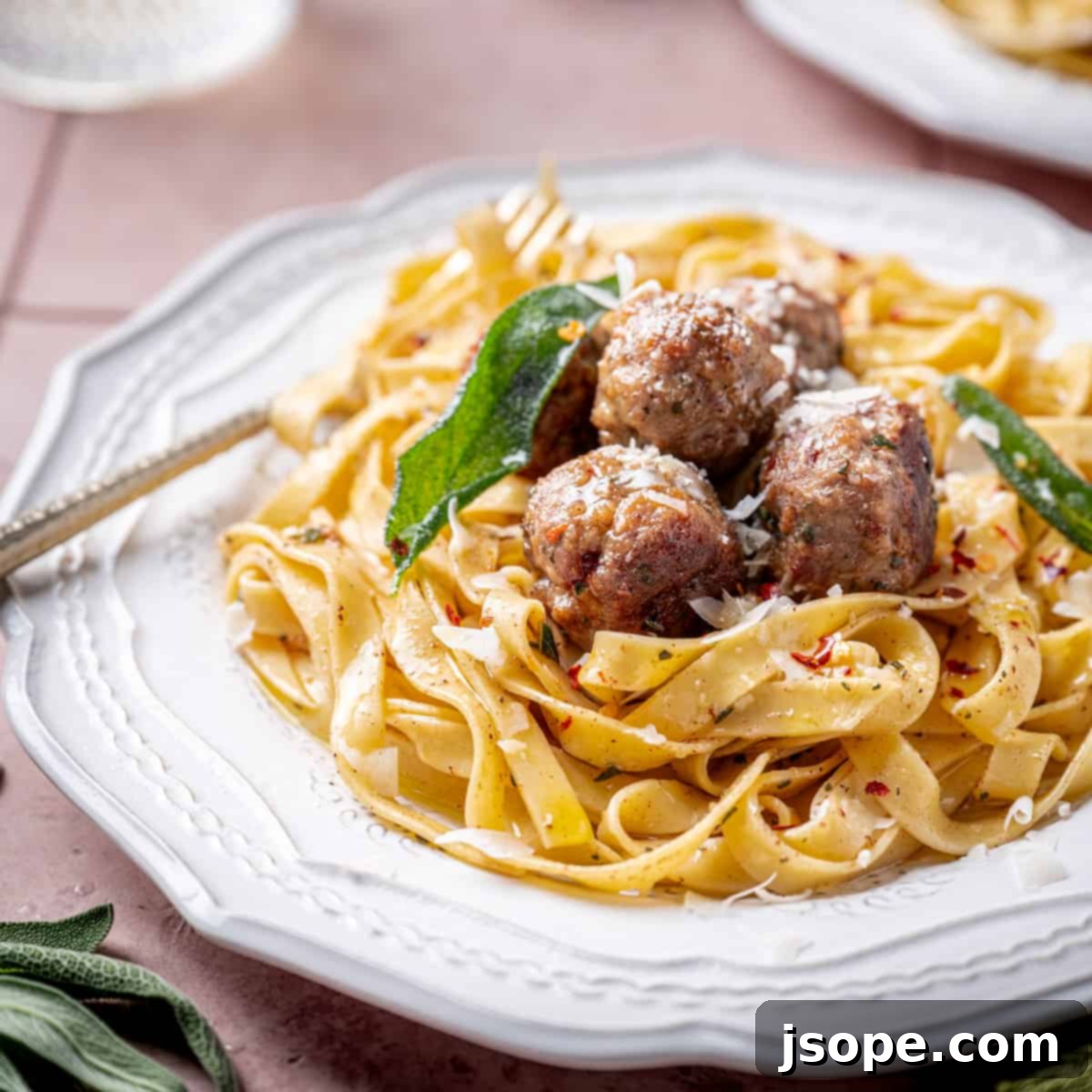Baked Veal Saltimbocca Meatballs in Brown Butter Sage Sauce
Experience the authentic, vibrant flavors of Rome reimagined in these incredibly tender and juicy meatballs! Veal Saltimbocca, a beloved Italian classic, translates to “jumps in the mouth,” and these meatballs certainly live up to that name. They’re bursting with savory prosciutto, aromatic fresh sage, and delicate veal, all baked to perfection and then enveloped in a luscious brown butter sage sauce. This recipe is not only simple and quick to prepare but also incredibly versatile, making it an ideal choice for a weeknight dinner or an impressive dish for entertaining. Get ready to fall in love with these Baked Veal Saltimbocca Meatballs in Brown Butter Sage Sauce.
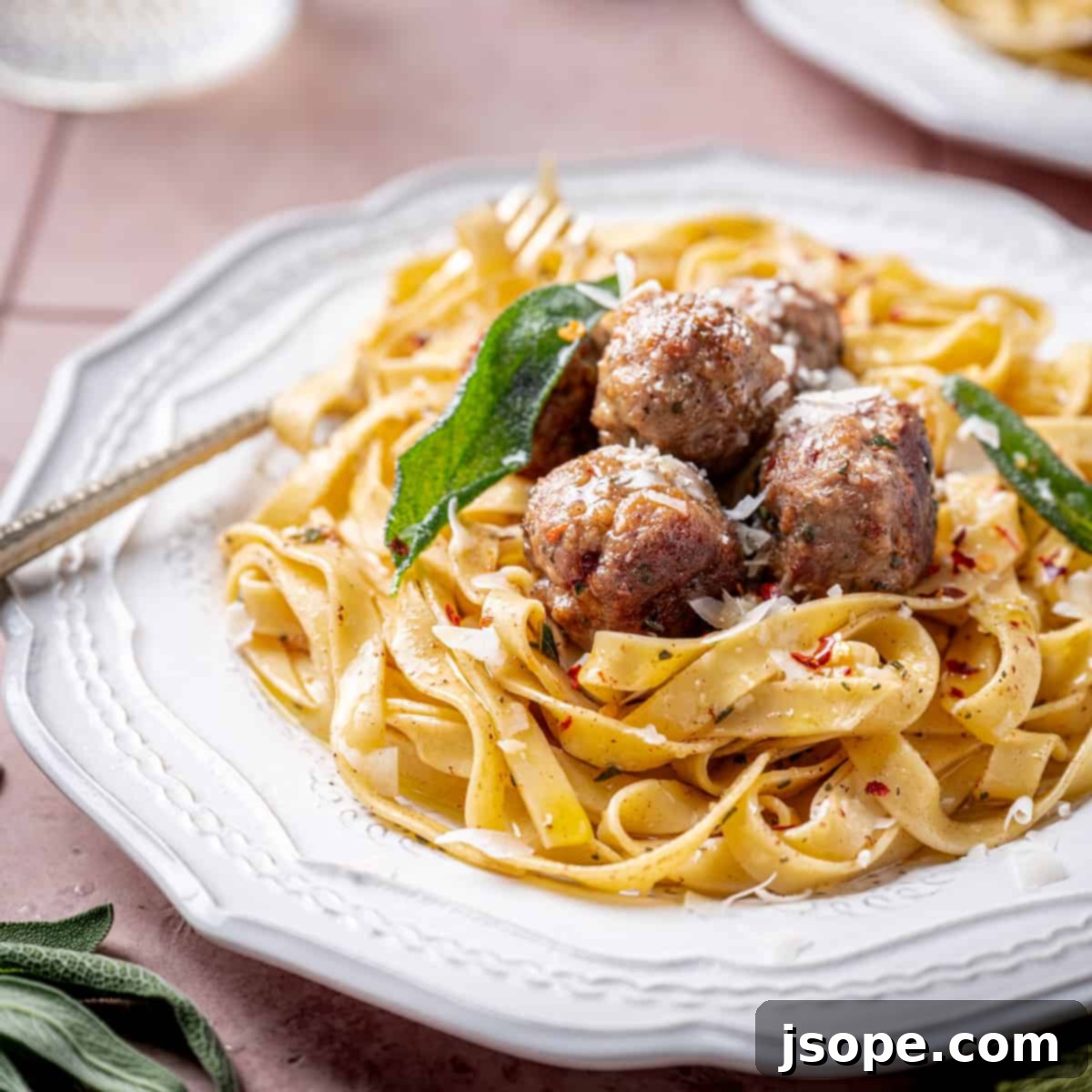
If you’re interested in exploring the classic Italian preparation, check out our recipe for Saltimbocca alla Romana. For more exquisite Italian veal dishes, consider trying our Italian White Ragù with Veal and Pork (Ragù Bianco).
What is Veal Saltimbocca?
Veal Saltimbocca, famously known as Saltimbocca alla Romana, is a distinguished Italian dish that proudly hails from the historic city of Rome. Its intriguing name, “Saltimbocca,” directly translates to “jumps in the mouth,” a testament to the dish’s incredibly impactful and harmonious flavor profile that delights the palate. At its core, traditional Saltimbocca features tender veal scallopini, thinly pounded veal cutlets, layered with savory prosciutto and fresh, aromatic sage leaves.
The preparation typically involves cooking these ingredients in butter and white wine, creating a rich and flavorful sauce. The assembly can vary; some prefer to roll up the veal with the prosciutto and sage inside, while others keep the components flat, securing them to the veal with toothpicks before cooking. Both methods yield an absolutely delicious result, making the choice a matter of personal preference. While traditionally crafted with veal, the versatility of the Saltimbocca concept means it can also be successfully made with other proteins like chicken or pork, offering fantastic variations on the classic Roman theme.
For another timeless Roman recipe, explore our guide to Chicken Piccata, which can also be easily adapted to make a delightful Veal Piccata.
Veal vs. Beef Meatballs: A Flavor Comparison
While both veal and beef originate from cattle, they offer distinctly different flavor and textural experiences, especially when prepared as meatballs. Understanding these differences can help you appreciate why veal is such a unique and fitting choice for our Saltimbocca-inspired meatballs.
Beef Meatballs: Ground beef is incredibly versatile, available in various lean-to-fat ratios, catering to diverse culinary preferences. Beef boasts a robust, distinctive “beefy” flavor that becomes wonderfully caramelized and deep in color when cooked. Its assertive taste pairs well with a wide array of aggressive seasonings and is a staple in many global cuisines, from classic Italian-American Sunday gravy to spicy Asian preparations.
Veal Meatballs: In contrast, ground veal is generally leaner and lighter than beef, presenting a more delicate, sweeter, and subtle flavor profile. Its texture is notably more tender, and it cooks to a lighter color and density. This understated elegance makes veal an ideal canvas for complementary flavors that are equally refined. Unlike beef, which can stand up to strong spices, veal shines when paired with a few thoughtfully chosen ingredients that enhance its natural sweetness without overpowering it. In terms of texture and nuanced flavor, ground veal shares some similarities with high-quality ground pork or even chicken, offering a sophisticated alternative to its beefier counterpart.
For those who love delicious Italian meatballs, be sure to check out our recipe for Italian Meatball Sub Sandwiches!
Why You’ll Love These Baked Veal Saltimbocca Meatballs
- Tender and Juicy Meatballs: Ground veal inherently lends itself to creating exceptionally tender meatballs. When combined with the right binding agents and cooked gently, as in baking, these meatballs retain their moisture, resulting in a delightfully juicy bite every time.
- Effortless Oven Baking: Forget the splattering oil and constant turning of pan-frying. Baking these meatballs in the oven is a hands-off approach that guarantees even cooking, less mess, and consistently perfect results. It’s the ultimate convenience for busy home cooks.
- Insanely Delicious Flavor: The combination of delicate veal, salty prosciutto, aromatic sage, and a hint of red pepper flakes creates a complex and deeply satisfying flavor profile that truly “jumps into your mouth.” Each ingredient plays a crucial role in mimicking the beloved Saltimbocca taste.
- Excellent for Freezing: These meatballs are perfect for meal prepping! Cook a large batch, and easily freeze the leftovers for future meals. They hold their texture and flavor beautifully, making them a fantastic freezer-friendly option for quick dinners.
- Reheats Wonderfully: Whether thawed from frozen or simply leftover from the fridge, these meatballs reheat without losing their tender texture or delicious taste. They’re just as good the next day, making them ideal for packed lunches or spontaneous meals.
Essential Ingredients for Veal Saltimbocca Meatballs
Crafting these delectable Veal Saltimbocca Meatballs requires a thoughtful selection of fresh, high-quality ingredients that build upon the classic Italian flavors. Here’s what you’ll need to create this culinary masterpiece:

- Ground Veal: The star of our meatballs, ground veal provides a lean, tender, and subtly sweet base. It’s becoming increasingly accessible in most grocery stores, often found alongside other ground meats. Its delicate nature makes it an exquisite choice for these flavorful meatballs.
- Prosciutto: A cornerstone of traditional veal saltimbocca, thinly sliced prosciutto adds a crucial layer of salty, savory depth and umami to the meatballs. Prosciutto di Parma is widely available, but if you can find Prosciutto di San Daniele, its slightly sweeter profile offers an extra layer of complexity. Any good quality sliced prosciutto will elevate the dish.
- Fresh Sage Leaves: The earthy, floral, and distinctly aromatic flavor of fresh sage is indispensable for authentic Saltimbocca. It provides a fragrant counterpoint to the richness of the veal and prosciutto, creating that signature taste.
- Red Pepper Flakes: A small addition of crushed red pepper flakes introduces a subtle warmth and distinctive piquancy to the meatballs, enhancing their overall flavor without making them overtly spicy.
- Kosher Salt and Black Pepper: Essential for seasoning, these basic spices bring out the best in all the other ingredients. Proper seasoning is key to balancing the rich flavors.
- Egg Yolk: Since veal is a lean meat, an egg yolk adds necessary richness to the meatballs, ensuring they remain moist and flavorful. It also acts as an excellent binding agent, helping the meatballs hold their shape during baking.
- Breadcrumbs: We prefer panko breadcrumbs for their light texture, which contributes to a tender meatball. Toasting them first adds another layer of nutty flavor. Italian breadcrumbs can also be used effectively.
- Extra Virgin Olive Oil: A touch of olive oil contributes to the meatballs’ richness and improves their mouthfeel. A standard quality EVOO is perfectly suitable here.
- Parmesan Cheese: A small amount of authentic Parmigiano Reggiano lends a wonderful savory depth and an additional layer of richness, complementing the other Italian flavors beautifully.
- Unsalted Butter: This forms the delicious base of our brown butter sage sauce. Using unsalted butter allows you to control the overall saltiness of the dish.
- Dry White Wine: When deglazed into the browned butter, dry white wine adds acidity and complexity, transforming simple butter into a rich, cohesive sauce. A crisp, dry Sauvignon Blanc or Pinot Grigio is an excellent choice.
Refer to the full recipe card below for exact quantities.
Thoughtful Substitutions for Your Veal Saltimbocca Meatballs
While this recipe is designed to capture the classic essence of Veal Saltimbocca, sometimes ingredient availability or dietary preferences call for adjustments. Here are a few common and effective substitutions you can make:
- Fresh Sage Leaves: If fresh sage is unavailable, you can use dried sage. As dried herbs are more concentrated, use about one-third the amount of fresh sage. Keep in mind that fresh sage offers a brighter, more pungent flavor, so the overall aroma will be slightly different.
- Prosciutto: While prosciutto is irreplaceable for the authentic Saltimbocca flavor, you could experiment with other high-quality cured hams. Options like Spanish Jamón Ibérico, Portuguese Presunto, or even Culatello (another exquisite Italian cured ham) could offer unique, albeit different, flavor profiles. Ensure they are thinly sliced for the best integration into the meatballs.
- Parmesan Cheese: For a slightly sharper, saltier kick, Pecorino Romano cheese makes a wonderful substitute for Parmesan. Its distinct flavor pairs beautifully with the other robust ingredients in this recipe.
- Ground Veal: If ground veal is difficult to source or if you prefer an alternative, ground pork is the closest in terms of leanness and subtle flavor, offering excellent results. Ground chicken or turkey can also be used for a lighter option, though they will alter the traditional flavor and texture profile more significantly.
How to Make Baked Veal Saltimbocca Meatballs in Brown Butter Sage Sauce
These flavorful meatballs are surprisingly straightforward to prepare, and by baking them, you minimize cleanup while maximizing flavor development. Follow these easy steps to create a delightful Italian meal:
Equipment You’ll Need
- Large bowl: For thoroughly mixing all the meatball ingredients.
- Sheet tray: Essential for baking the meatballs evenly. Lining it with parchment paper ensures easy cleanup and prevents sticking.
- Sauté pan: Used for toasting the panko breadcrumbs and, subsequently, for crafting the rich brown butter sage sauce.
Step-by-Step Instructions
Achieving perfect meatballs and a luscious sauce is simpler than you think. Pay attention to the details, and you’ll be rewarded with an unforgettable dish.
- Step 1: Toast the Panko for Enhanced Flavor
Begin by placing the panko breadcrumbs in a dry sauté pan over medium heat. Toast the breadcrumbs, stirring or flipping them frequently, until they turn a beautiful golden brown color. This process takes approximately 3 minutes and will release a wonderfully nutty aroma, significantly enhancing the flavor of your meatballs. Once toasted, immediately remove them from the heat and spread them on a plate to cool completely before incorporating them into the meat mixture.
- Step 2: Combine the Meatball Ingredients
In a large mixing bowl, combine the cooled toasted panko breadcrumbs with the ground veal, finely chopped prosciutto, fresh sage, kosher salt, black pepper, crushed red pepper flakes, extra virgin olive oil, egg yolk, and grated Parmesan cheese. We recommend using clean gloves and mixing the ingredients by hand to ensure everything is thoroughly and evenly incorporated without overworking the meat, which can lead to tough meatballs.
- Step 3: Shape the Meatballs
Preheat your oven to 375°F (190°C). Once your meat mixture is ready, gently roll it into uniform 1-inch balls. Aim for consistent size to ensure even cooking. Place the shaped meatballs on a baking sheet lined with parchment paper, leaving a little space between each. This recipe typically yields between 25 and 30 meatballs.
- Step 4: Bake the Meatballs to Perfection
Transfer the baking sheet with the meatballs to the preheated oven. Bake for approximately 20-25 minutes. Begin checking for doneness around the 20-minute mark. You can cut one meatball in half to visually confirm it’s cooked through, or for precision, use an instant-read thermometer. The internal temperature should reach 160°F (71°C), as they will continue to cook slightly (carry over) to a perfect 165°F (74°C) once removed from the oven.
- Step 5: Craft the Irresistible Brown Butter Sage Sauce
While the meatballs are baking, prepare the sauce. In the same sauté pan (or a clean one), melt the unsalted butter over medium heat. Continue cooking the butter, swirling occasionally, until it just begins to turn a light golden brown and emits a delightful, nutty aroma. This usually takes about 5 minutes. Be vigilant, as butter can go from perfectly browned to burnt very quickly. Immediately add a pinch of salt, black pepper, and the finely chopped fresh sage. Let it sizzle for a few seconds to infuse the butter with sage flavor. Then, carefully pour in the dry white wine and whisk vigorously. The wine will bubble significantly as it deglazes the pan and combines with the butter. Continue to cook and whisk for a few minutes until the sauce slightly thickens and achieves a cohesive texture. Taste for seasoning and adjust with more salt and pepper if needed.
- Step 6: Serve and Enjoy!
Once the meatballs are baked and the sauce is ready, you can either gently toss the meatballs directly in the brown butter sage sauce or serve the sauce generously spooned over them. These meatballs are fantastic on their own, as an appetizer, or tossed with your favorite pasta for a complete meal.
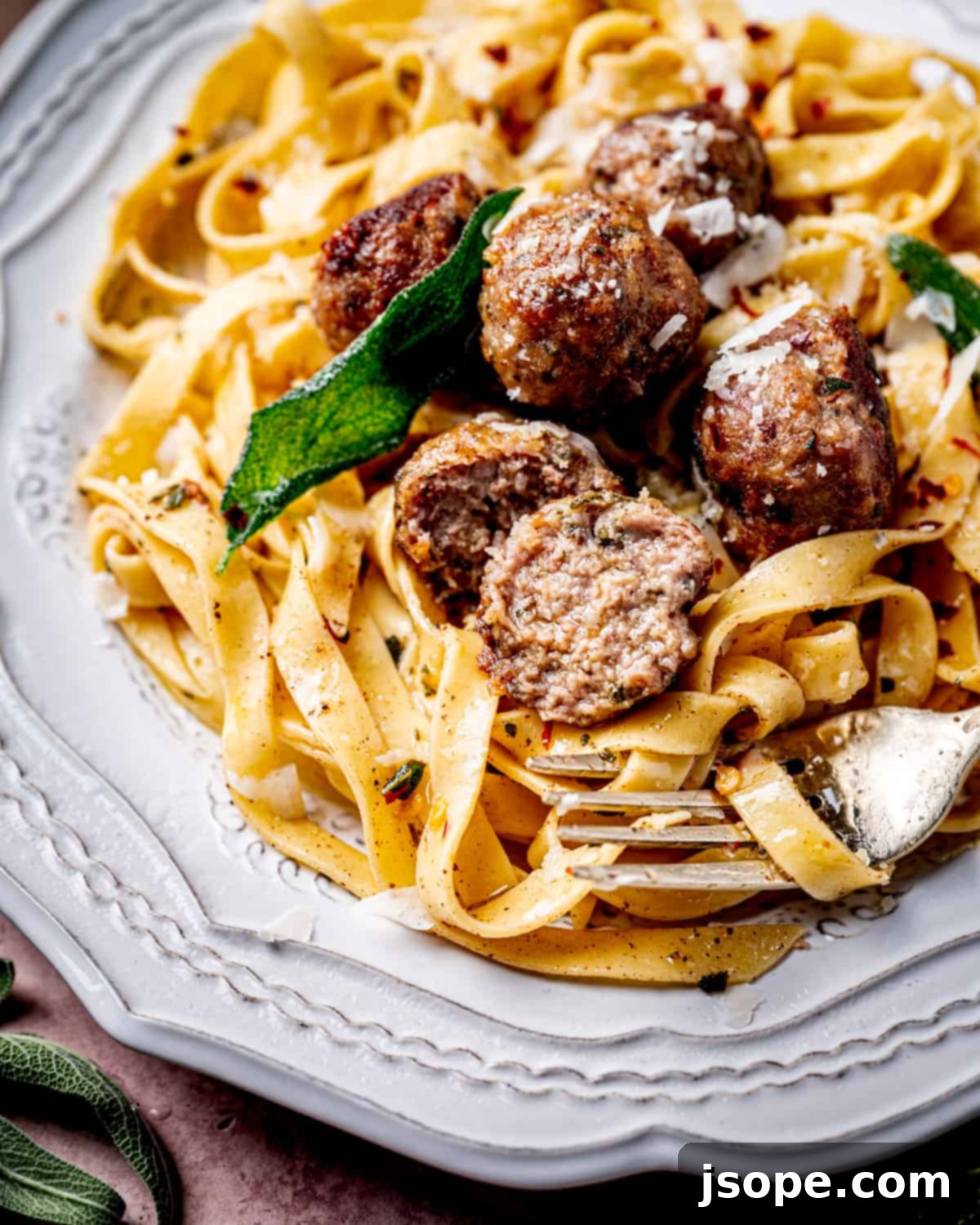
Creative Variations for Your Saltimbocca Meatballs
While this recipe is carefully designed to capture the exquisite, classic flavors of veal saltimbocca in meatball form, you can certainly explore variations to suit your taste or ingredients on hand. Keep in mind that significant changes might alter the “saltimbocca” character, but they will still yield delicious results.
- Experiment with Different Herbs: Although sage is the signature herb for Saltimbocca, you can introduce other fresh herbs for a different aromatic profile. Consider using fresh rosemary, thyme, or oregano for more earthy notes, or even fresh parsley for a brighter, more herbaceous flavor. A combination of these herbs could also create a unique blend.
- Choose an Alternative Protein: If veal is not an option, a lean, high-quality ground pork is the recommended substitute, offering a similar tender texture and subtle sweetness, though the overall flavor will be distinctly different. For lighter options, ground chicken or turkey can also be used. While delicious, these proteins will change the original essence of the dish, delivering a different but still enjoyable experience. Beef could also be used for a more robust flavor, but its strong profile might overshadow the delicate sage and prosciutto.
- Make it Gluten-Free: Adapting this recipe for a gluten-free diet is simple. Replace traditional panko breadcrumbs with gluten-free panko breadcrumbs. Ensure all other ingredients, especially broths or wines, are also certified gluten-free if strict adherence is required.
- Serve with a Different Sauce: While the brown butter sage sauce is a perfect match for these meatballs, you can certainly explore other sauce options. A classic tomato sauce, such as a rich Sugo di Pomodoro or a vibrant Marinara Sauce, would offer a more traditional Italian meatball experience. For something creamier and equally decadent, a Parmesan Sage Cream Sauce would also be an excellent choice.
Storage and Reheating Tips for Veal Saltimbocca Meatballs
These Veal Saltimbocca Meatballs are excellent for making ahead or enjoying as leftovers. Proper storage ensures they remain delicious and safe to eat.
How to Store Leftover Veal Meatballs:
- Once cooled to room temperature, place the baked veal meatballs (with or without the sauce) in an airtight container. Store them in the refrigerator for up to 5 days. Ensure they are fully cooled before sealing to prevent condensation and maintain freshness.
How to Reheat Leftover Veal Meatballs:
- Stovetop Method: For best results, place the meatballs in a covered skillet over medium-low heat with a teaspoon or two of water or extra sauce. Shake the pan occasionally to gently turn the meatballs, ensuring they warm through evenly without drying out.
- Oven Method: Alternatively, arrange the meatballs in a covered casserole dish and warm them in a 325°F (160°C) oven until heated through. This method might take a bit longer but ensures gentle reheating.
Can You Freeze Veal Meatballs?
- Yes, these meatballs freeze beautifully! Allow the fully cooked meatballs to cool completely. You can freeze them with or without the brown butter sage sauce. Place them in a single layer on a baking sheet to freeze solid, then transfer them to a freezer-safe bag or airtight container. They will maintain their quality for up to 3 months.
- To Reheat from Frozen: Thaw the meatballs in the refrigerator overnight. Once thawed, reheat them using the stovetop or oven methods described above.
Top Tip for Perfect Meatballs
Keep the Meatballs Small: For optimal results, aim to shape your meatballs smaller than the size of a golf ball, ideally around 1 inch in diameter. Larger meatballs tend to flatten out during the baking process, losing their desirable round shape. Additionally, the cooking times and temperatures provided in this recipe are calibrated for smaller meatballs, ensuring they cook evenly and thoroughly without becoming dry.
Troubleshooting Common Issues with the Sauce
This recipe is designed to be straightforward, but cooking, especially with brown butter, sometimes requires a keen eye. The most common issue you might encounter is with the brown butter sage sauce.
Overcooking the Brown Butter: When making the brown butter, it’s crucial to watch it carefully. The milk solids in the butter will first melt, then foam, and finally start to turn golden brown and smell nutty. This is the sweet spot. If you continue to cook the butter past this point, the milk solids will turn dark brown or even black, resulting in a bitter, unpleasant, and burnt-tasting sauce. Unfortunately, once butter burns, it cannot be salvaged. If this happens, it’s best to discard it and start fresh with new butter. Don’t worry, it’s a quick process, and ensuring your sauce is perfect is worth the minimal effort.
What to Serve with Veal Saltimbocca Meatballs
These incredibly flavorful meatballs, especially with their rich brown butter sage sauce, pair wonderfully with a variety of sides that complement their Italian heritage.
- Pasta: A classic choice! We particularly love them tossed with homemade fettuccine, but any pasta shape will be delicious. The sauce clings beautifully to the noodles, making for a satisfying meal.
- Creamy Sides: For a comforting and decadent pairing, serve the meatballs with creamy polenta, fluffy mashed potatoes, or a silky cauliflower puree for a lighter, low-carb option. These rich bases absorb the sauce perfectly.
- Grains: If you prefer grains, farro or rice make excellent accompaniments, adding a pleasant textural contrast to the tender meatballs.
- Crusty Bread: Don’t forget a good quality crusty Italian or French bread! It’s absolutely essential for sopping up every last drop of the delectable brown butter sage sauce.
- Roasted Vegetables: A simple side of roasted asparagus, green beans, or broccoli would add a fresh, vibrant element to the meal.
Perfect Wine Pairings for Veal Saltimbocca Meatballs
Selecting the right wine can elevate your dining experience with these Veal Saltimbocca Meatballs. The rich flavors of veal, prosciutto, and sage, along with the nutty brown butter sauce, call for a thoughtful pairing.
- Red Wine Recommendations: Surprisingly, a lighter-bodied red wine often pairs best with these meatballs. A classic Chianti or any 100% Sangiovese wine from Italy is an excellent choice, offering bright acidity and savory notes that cut through the richness of the meat and sauce. Another fantastic option is a delicate Pinot Noir, which provides red fruit characteristics and earthy undertones without overpowering the subtle veal flavor.
- White Wine Options: While the sauce is made with white wine, a dry white wine can still be a good accompaniment if you prefer. We recommend serving the same dry white wine that you used in the sauce, such as a crisp Sauvignon Blanc or a clean Pinot Grigio. Their acidity can provide a nice counterpoint to the buttery sauce.
- Rosé Alternative: Interestingly, an Italian or French rosé can offer a refreshing and versatile pairing. The dryness and fruit notes of a quality rosé can bridge the gap between the richness of the meat and the herbal components, creating a balanced and delightful complement.
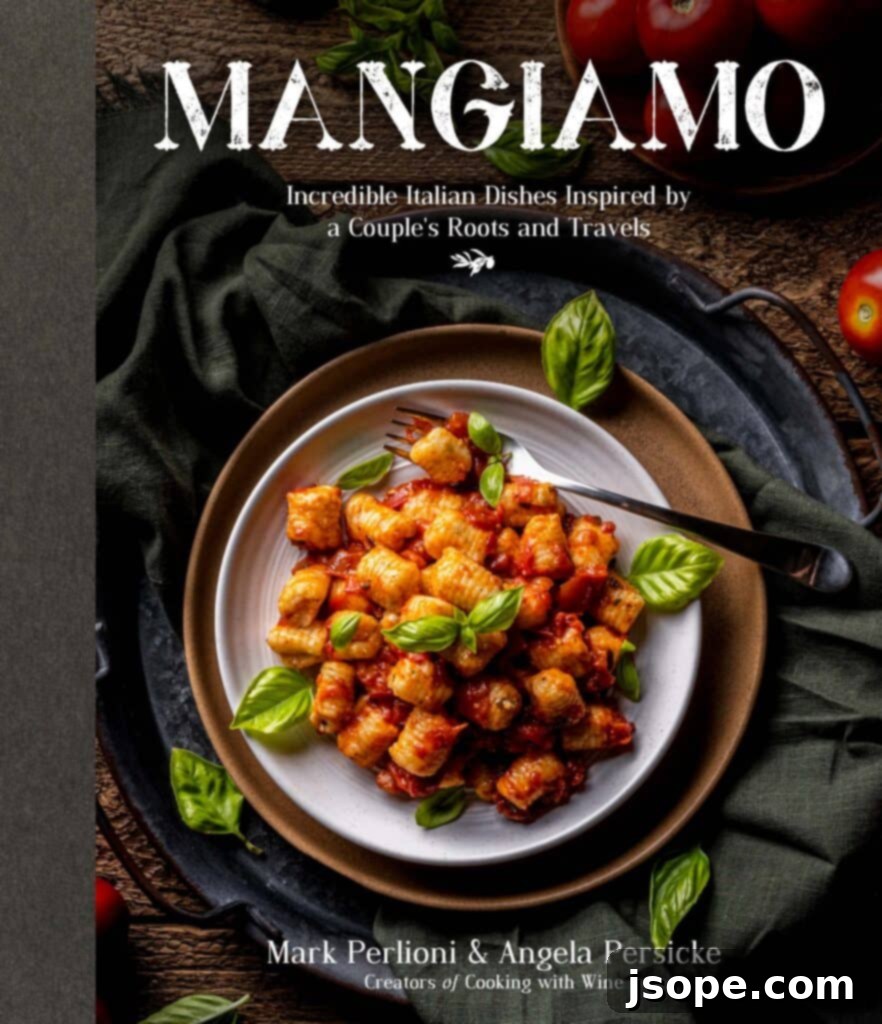
Explore More Italian Delights with Our Mangiamo Cookbook
Unlock a world of authentic Italian flavors with our acclaimed cookbook, Mangiamo. Featuring 60 mouth-watering Italian recipes, each accompanied by drool-worthy images, this cookbook is a culinary journey inspired by our rich Italian roots and extensive travels across Italy. Discover traditional dishes and new favorites to share with your loved ones.
Order Your Copy Today →
Frequently Asked Questions About Veal Saltimbocca Meatballs
Veal offers a uniquely tender texture and a subtly sweet, delicate flavor profile that is distinct from beef. When used in meatballs, either on its own or blended with other meats, it results in an exceptionally tender and juicy meatball that takes on complementary flavors beautifully, making it perfect for elegant dishes like Saltimbocca.
Both baking and pan-searing are effective methods, and neither is definitively “better”—it largely depends on your preference and desired outcome. Pan-searing provides a crispy, deeply browned exterior and can be quicker. However, we prefer baking these meatballs for their ease and even cooking. Baking offers a consistent golden-brown crust without the need for constant attention or excess oil, resulting in a perfectly cooked and tender meatball every time. You can also combine methods by searing briefly for color, then finishing in the oven.
In terms of leanness and a more subtle flavor compared to beef, high-quality ground pork is often considered the closest substitute for ground veal. However, there isn’t a direct, perfect substitute for veal’s unique characteristics. For ground applications, ground chicken and turkey can also offer a similar texture, but their flavor profiles are distinct.
For consistently tender and flavorful meatballs, we favor a combination of a small amount of panko breadcrumbs and an egg yolk. Panko provides a light, airy texture, while the egg yolk adds richness and ensures the meatballs hold their shape without becoming dense. This combination effectively binds the ingredients without overpowering the primary flavor profile of the meat.
More Italian Recipes You’ll Love
If you enjoyed this recipe, you might also like these other delicious Italian creations:
- Homemade Butternut Squash Ravioli Recipe
- Italian Herb Sautéed Zucchini Squash Recipe
- Garlic Herb Sautéed Italian Eggplant Recipe
- Pan Fried Risotto Cakes – Easy Leftover Risotto Recipe
See more Classic Italian →
Delightful Dessert Pairings
Complete your Italian meal with one of our favorite desserts that perfectly complement the rich flavors of these meatballs:
- Creamy Coffee Panna Cotta with Chocolate Ganache
- Soft Pumpkin Ricotta Cookies with Cream Cheese Frosting
- Limoncello Ricotta Tiramisù (Easy Twist on Classic Tiramisù)
- Classic Easy Vanilla Panna Cotta with Blueberry Compote
See more Desserts →
📖 Recipe: Baked Veal Saltimbocca Meatballs in Brown Butter Sage Sauce
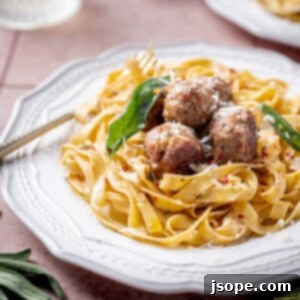
Baked Veal Saltimbocca Meatballs in Brown Butter Sage Sauce
The classic Veal Saltimbocca alla Romana recipe transformed into an easy-to-make baked meatball form! These tender and flavorful meatballs are served in a delicious Brown Butter Sage Sauce.
Pin Recipe
Preparation Details
- Prep Time: 20 minutes
- Cook Time: 25 minutes
- Total Time: 45 minutes
Categorization
- Course: Main Course
- Cuisine: Italian
Servings & Nutrition
- Servings: 4
- Calories: 435 kcal
Equipment
- 1 Large bowl
- 1 Large sauté pan
- 1 Large sheet tray with parchment paper
Ingredients
For the Meatballs:
- ¼ cup panko breadcrumbs (toasted)
- 1 lb ground veal
- 1 teaspoon kosher salt
- Pinch of black pepper
- 1 teaspoon crushed red pepper flakes
- 4 slices prosciutto, finely chopped
- 2 Tablespoons fresh sage, finely chopped
- 1 teaspoon extra virgin olive oil
- 1 egg yolk
- ¼ cup grated Parmesan cheese
For the Sauce:
- 6 Tablespoons unsalted butter
- Pinch of kosher salt and black pepper
- 2 teaspoons finely chopped fresh sage
- ⅓ cup dry white wine
Instructions
- Add the breadcrumbs to a dry sauté pan over medium heat. Cook the breadcrumbs, flipping or stirring often, until they are a golden brown color (approx 3 minutes). Remove from the heat and let the breadcrumbs cool on a plate.
- Combine all of the ingredients for the meatballs (cooled panko, ground veal, kosher salt, black pepper, crushed red pepper flakes, finely chopped prosciutto, finely chopped fresh sage, extra virgin olive oil, egg yolk, and grated Parmesan cheese) in a large bowl. We recommend using gloves and mixing by hand until just combined.
- Preheat the oven to 375°F (190°C). Shape the meat mixture into about 1-inch balls and place them on a parchment paper lined baking sheet. You should have between 25 and 30 meatballs.
- Place the meatballs in the preheated oven and bake for about 20-25 minutes. Begin checking for doneness starting at 20 minutes. We cut one in half to ensure it is cooked, but you can also use an instant-read thermometer (an internal temperature of 160°F is perfect, as they will carry over to 165°F).
- Melt the butter in the sauté pan over medium heat. Continue to cook the butter until it just starts turning brown and develops a nutty smell (approx 5 minutes). Add some salt, pepper, and the remaining finely chopped fresh sage for a few seconds. Then, add the dry white wine and whisk vigorously. The wine will bubble significantly. Cook the sauce and whisk for a few minutes until it thickens slightly and combines well. Taste for seasoning and adjust with salt and pepper to taste.
- Serve the meatballs generously coated with the sauce, or toss them with your favorite pasta if you wish!
Nutrition Information (per serving)
- Calories: 435 kcal
- Carbohydrates: 5 g
- Protein: 26 g
- Fat: 32 g
- Saturated Fat: 17 g
- Polyunsaturated Fat: 2 g
- Monounsaturated Fat: 10 g
- Trans Fat: 1 g
- Cholesterol: 197 mg
- Sodium: 878 mg
- Potassium: 443 mg
- Fiber: 1 g
- Sugar: 1 g
- Vitamin A: 795 IU
- Vitamin C: 0.003 mg
- Calcium: 120 mg
- Iron: 2 mg
Keywords
brown butter, butter sauce, classic Italian recipes, ground veal, meatballs, prosciutto, sage, veal
Let us know how it was!
Important Food Safety Guidelines
Ensuring food safety is paramount when preparing any meal. Please adhere to the following guidelines to prevent foodborne illness and ensure a healthy cooking experience:
- Cook to Minimum Temperature: Always cook ground meat, like veal, to a minimum internal temperature of 165°F (74°C). Use an instant-read thermometer to verify doneness.
- Prevent Cross-Contamination: Never use the same utensils, cutting boards, or plates on cooked food that previously touched raw meat without thoroughly washing them first.
- Hand Washing: Wash your hands thoroughly with soap and warm water for at least 20 seconds after handling raw meat.
- Avoid Extended Room Temperature: Do not leave cooked food sitting out at room temperature for more than two hours. If the ambient temperature is above 90°F (32°C), reduce this time to one hour.
- Never Leave Cooking Unattended: Always supervise food while it’s cooking, especially when using high heat or frying.
- High Smoke Point Oils: When cooking with oil, choose those with a high smoking point to avoid the production of harmful compounds.
- Ensure Good Ventilation: Always use good ventilation when operating a gas stove, as it can release pollutants into the air.
For more comprehensive food safety information and guidelines, please refer to USDA.gov.
